Weimaraner
The Weimaraner (/ˈwaɪmərɑːnər/ WY-mə-rah-nər) is a large dog that was originally bred for hunting in the early 19th century.[3] Early Weimaraners were used by royalty for hunting large game such as boar, bear and deer. As the popularity of large game hunting began to decline, Weimaraners were used for hunting smaller animals like fowl, rabbits and foxes.
| Weimaraner | |||||||||||||||||||||
|---|---|---|---|---|---|---|---|---|---|---|---|---|---|---|---|---|---|---|---|---|---|
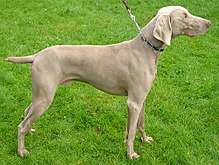 Male Weimaraner with docked tail | |||||||||||||||||||||
| Common nicknames | Raner Grey Ghost | ||||||||||||||||||||
| Origin | Germany | ||||||||||||||||||||
| |||||||||||||||||||||
| |||||||||||||||||||||
| Dog (domestic dog) | |||||||||||||||||||||
The Weimaraner is an all-purpose gun dog. The name comes from the Grand Duke of Saxe-Weimar-Eisenach, Karl August, whose court, located in the city of Weimar (now in the state of Thuringia in modern-day Germany), enjoyed hunting.
History
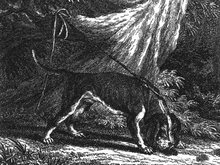
The Weimaraner was kept in the Weimar court in the 19th century and carried a good deal of Leithound ancestry.[1] Two theories propose that they descended from the Chien-gris dogs,[4] or the St. Hubert Hound whose descendant is the Bloodhound.[5]
Description
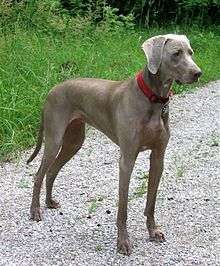
Appearance
The Weimaraner is athletic in appearance. Traditionally, the tail is docked. In countries where this is still carried out, the docked tail should measure approximately 6 inches in the adult dog, and this is part of the American Kennel Club breed standard. Tail docking is illegal in several countries, where the breed is shown with an entire tail. The British Kennel Club breed standard describes a tail reaching to the hocks and carried below the level of the back when relaxed, and the German breed club standard calls for a full tail that is strong and well coated, which can be carried above the line of the back when the dog is working. Weimaraners are great water dogs as evidenced by their webbed paws.
The eyes of the Weimaraner may be light amber, grey or blue-grey.
Coat and color
.jpg)
This breed's short coat and unusual eyes give it a distinctive regal appearance. The coat is extremely low-maintenance, short, hard, and smooth to the touch, and may range from charcoal-blue to mouse-grey to silver-grey or even blue-grey. Where the fur is thin or non-existent, inside the ears or on the lips for example, the skin should be pinkish rather than white or black. This breed does not have an undercoat, so extreme cold should be avoided. While their coat is short, this breed does shed. The Weimaraner's coat color led to its nickname of "the Grey Ghost".
In November 2009 and January 1, 2010, the United Kennel Club (UKC) removed the disqualification from both Blue and Longhair Weimaraners. A black coat remains an automatic disqualification, though a small white marking in the chest area only is permitted. Dogs with blue coats are disqualified from conformation/show competition,[6] but are recognized as purebred Weimaraners by the AKC. There is another incidental variety, described as having the "mark of the hound", where the dog is the usual grey colour but with faint tan markings (similar to Doberman Pinschers). Weimaraners can have several unique physical characteristics such as small lobes on the inside of the ear, known as "Harrasburg Horns", and "Grafmar's Caps", very light gray patches between the ears.[7]
A long-haired variety is recognized by most kennel clubs around the world except the American Kennel Club. The long-haired Weimaraner has a silky coat with an undocked, feathered tail. The gene is recessive, so breeding will produce some long-haired puppies only if both parents carry the trait.
Size
According to the Fédération Cynologique Internationale standard, the male Weimaraner stands between 59 to 70 cm (23 to 28 in) at the withers. Females are between 57 to 65 cm (22 to 26 in). Males normally weigh about 30–40 kg (66–88 lb). Females are generally between 25–35 kg (55–77 lb).[1] A Weimaraner should give the appearance of a muscular, athletic dog.
 Short-haired male
Short-haired male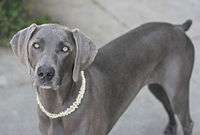 Female Weimaraner, short-haired
Female Weimaraner, short-haired Female Weimaraner, long-haired
Female Weimaraner, long-haired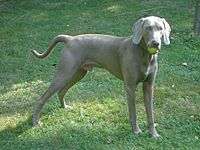 Weimaraner with uncropped tail
Weimaraner with uncropped tail Weimaraner
Weimaraner Short-haired male Weimaraner
Short-haired male Weimaraner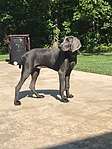 Blue male weimaraner with short hair and docked tail
Blue male weimaraner with short hair and docked tail
Temperament
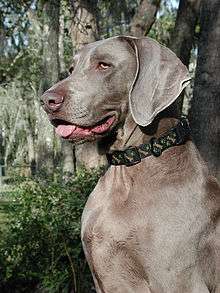

The Weimaraner is an energetic hunting dog, prized for its physical endurance and stamina, with a strong, instinctive prey-drive. It may tolerate cats but usually does not, tending to follow the urge to hunt—no matter how long it has known a particular cat—and likely to chase and kill any small animal that enters the garden. A Weimaraner requires frequent exercise and will appreciate games and play. An active owner is more likely to provide the vigorous exercise and games required. A Weimaraner requires appropriate training to learn how to be calm and control its behavior.
As a hunting dog
Weimaraners have an excessive amount of energy that requires a good outlet. They are well-rounded hunting dogs that excel at hunting, tracking, pointing and retrieving both on land and in the water. The Weimaraner is a very people-oriented breed. They have a very strong desire to work and live with their owners, making the breed a good choice for the novice hunter. It requires a gentle touch when training to hunt and it often learns best from a seasoned hunting dog.[8]
Behavior disorders
Weimaraners are not an independent breed and love to be with their owner, never leaving them alone. This can create very severe separation anxiety in the breed.[8] The causes of separation anxiety are not always known, but there are precluding factors including genetics, litter rearing, dominance, submission, boredom and stress. Weimaraners with severe separation anxiety can destroy property or injure themselves in trying to escape. Good training can curb some of the separation anxiety. A Weimaraner with separation anxiety is likely to bark, whine, howl and even dig until its owner returns home.[9] Further manifestations of this problem can include panicking and excessive drooling, along with destructive behaviors and injury.
Health
According to the Orthopedic Foundation for Animals, Weimaraners enjoy low rates of dysplasia. The breed is ranked 102nd of 153 total breeds and has a very high test rate and a very high percentage of excellent rating among those dogs tested.[10] It is generally recommended to acquire Weimaraners only from breeders who have their dogs' hips tested using OFA or PennHIP methods.
As a deep-chested dog, the Weimaraner is prone to bloat or gastric torsion, a very serious condition that can cause painful and rapid death when left untreated. It occurs when the stomach twists itself, thereby pinching off blood vessels and the routes of food traveling in or out. Symptoms include signs of general distress, discomfort, no bowel movement or sounds and a swollen stomach. Immediate medical attention is imperative when bloat occurs and surgery is the only option if it is caught early enough.
One way to help prevent bloat is to spread out the Weimaraner's feedings to at least twice daily and to avoid any vigorous exercise an hour before or after meals. It is also recommended that the dog's feeding dish not be placed on a raised platform to discourage it from gobbling its food too quickly and keep air from entering the stomach. Raised food bowls have been found to more than double the risk of bloat in large dogs.[11]
Skin allergies are common among weimaraners. A vet should be consulted if a dog starts to lose hair, itch constantly or develop rashes. Parasites can cause an allergic reaction in addition to the normal irritation resulting from bites.
Other health issues include:
- Cryptorchidism[12]
- Distichiasis[12]
- Elbow dysplasia[13]
- Entropion[14]
- Pituitary dwarfism[12][14]
- Hypertrophic osteodystrophy[14]
- Hypomyelinogenesis[14]
- Hypothyroidism[12]
- Progressive retinal atrophy
- Renal dysplasia[14]
- Von Willebrands Disease[12]
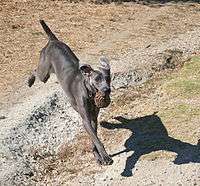 Weimaraner playing
Weimaraner playing Grand Duke Karl August of Weimar
Grand Duke Karl August of Weimar
See also
- William Wegman (photographer), known for his many photographs of the breed
References
- "Weimaraner standard" (PDF). FCI. Retrieved April 25, 2017.
- O’Neill, D. G.; Church, D. B.; McGreevy, P. D.; Thomson, P. C.; Brodbelt, D. C. (2013). "Longevity and mortality of owned dogs in England" (PDF). The Veterinary Journal. 198 (3): 638–43. doi:10.1016/j.tvjl.2013.09.020. PMID 24206631. "n=26, median=12.6, IQR=11.1–13.5"
- "Weimaraner". The Kennel Club. Retrieved December 26, 2016.
- Deep, John. "Weimaraner". 2puppies. Retrieved December 26, 2016.
- Kočov, Dr. Jana. "Weimaraner Breed History". Royal Splendour.
- Weimaraner Page
- Taguchi, Anne. "Smart Bumps, Harrasburg Horns and Other Weimaraner Peculiarities". JustWeimaraners. Taguchi, Anne.
- "Weimaraner: Pros and Cons of Owning a Weimaraner". Pettium.
- "Phase IV: Troubleshooting your Mission: Dealing with problem behaviors". Adonai's Weimaraners.
- "Weimaraner". OFFA.
- Bloat (GDV) Study
- "List of common problems afflicting Weimaraners". Weimaraner Club of America.
- FITZPATRICK, NOEL; SMITH, THOMAS J.; EVANS, RICHARD B.; YEADON, RUSSELL (February 2009). "Radiographic and Arthroscopic Findings in the Elbow Joints of 263 Dogs with Medial Coronoid Disease". Veterinary Surgery. 38 (2): 213–223. doi:10.1111/j.1532-950X.2008.00489.x. PMID 19236680.
- "Weimaraners". Canine Inherited Disorders Database. Archived from the original on February 19, 2007.
External links
| Wikimedia Commons has media related to Weimaraner. |